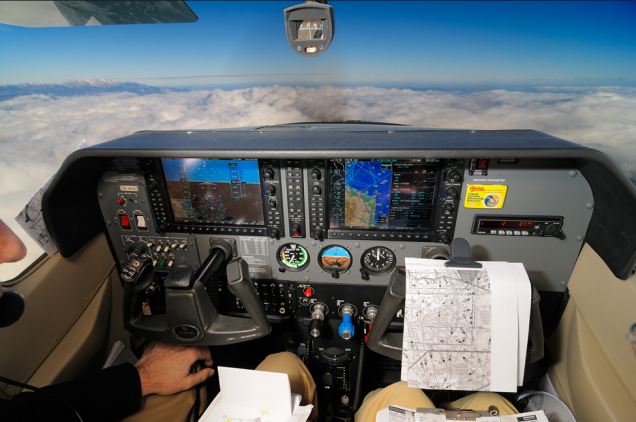
This post is intended to be a detailed response to the wannabe gyro debunkers that think research means hanging out in debunk forums, cutting and pasting the first excuse that triggers their confirmation bias in defence of the ball busting characteristics posed by gyroscopes.
The fallacy in question is that artificial horizon indicators run by gyroscopes use pendulous vanes to somehow automatically correct for the non-existent curvature of earth.
A Brief History Of Gyros
It’s important to know the time-line of gyroscope development in order to understand that gyros were in constant commercial/private use long before the introduction of any stabilising mechanisms like pendulous vanes, which were largely developed due to the exaggerated aerial manoeuvres needed during times of war.
The earliest patent I could find for a gyroscopic artificial horizon was filled by Joshua Nickerson Rowe in 1892.
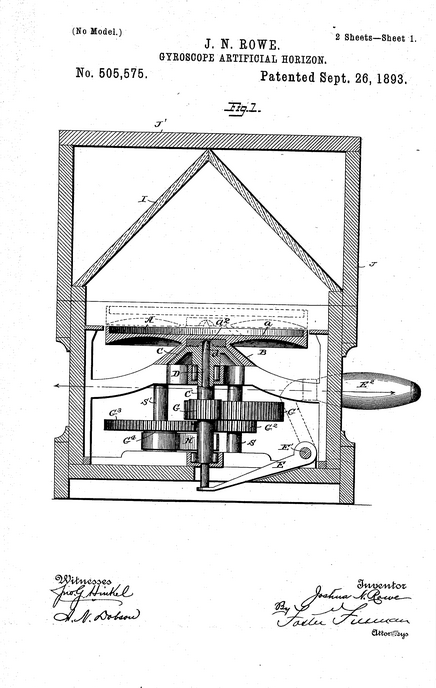
Gyroscopes were used in torpedoes and as ship stabilisers and navigation devices before they were used in aircraft. In 1909, Elmer A. Sperry built the first automatic pilot for aircraft using gyroscopes. Later in 1916 the first gyroscopic artificial horizon was used in a plane.
The first patent for a pendulous vanes system was filed in 1941 by the inventor Frederick D. Braddon, with the assignor being the Sperry Gyroscope Company, Inc.
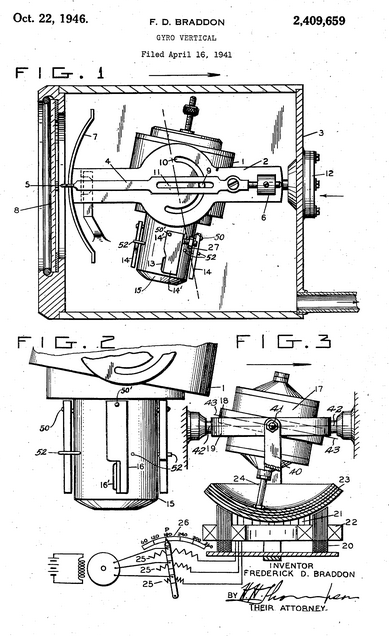
So it seems absurd to claim the invention of pendulous vaned gyros in the 40’s were the first to provided curvature correction, when non-stop transatlantic flight by Alcock and Brown was achieved in 1919. They flew from Newfoundland to Ireland which would have needed a curvature correction of more than 400 miles of drop. To realise why this curvature correction is absurd we need to quickly cover the basic principles of a gyro.
Two basic Principles of Gyroscopic Instruments
Gyroscopic instruments are essential instruments used on all aircraft. They provide the pilot with critical attitude and directional information and are particularly important while flying under IFR (Instrument Flight Rules). The sources of power for these instruments can vary. The main requirement is to spin the gyroscopes at a high rate of speed. Originally, gyroscopic instruments were strictly vacuum driven. A vacuum source pulled air across the gyro inside the instruments to make the gyros spin. Later, electricity was added as a source of power. The turning armature of an electric motor doubles as the gyro rotor. Various systems and powering configurations have been developed to provide reliable operation of the gyroscopic instruments.
Three of the most common flight instruments, the attitude indicator, heading indicator, and turn needle of the turn-and-bank indicator, are controlled by gyroscopes. A mechanical gyroscope is comprised of a wheel or rotor with its mass concentrated around its perimeter. The rotor has bearings to enable it to spin at high speeds. [Figure 10-93A]
Different mounting configurations are available for the rotor and axle, which allow the rotor assembly to rotate about one or two axes perpendicular to its axis of spin. To suspend the rotor for rotation, the axle is first mounted in a supporting ring. [Figure 10-93B] The ring and rotor can both move freely 360°. When in this configuration, the gyro is said to be a captive gyro. It can rotate about only one axis that is perpendicular to the axis of spin. [Figure 10-93C]
Attachment of a bracket to the outer ring allows the rotor to rotate in two planes while spinning. Both of these are perpendicular to the spin axis of the rotor. The plane that the rotor spins in due to its rotation about its axle is not counted as a plane of rotation.
A gyroscope with this configuration, two rings plus the mounting bracket, is said to be a free gyro because it is free to rotate about two axes. [Figure 10-93D] As a result, the supporting ring with spinning gyro mounted inside is free to turn 360° inside the outer ring.
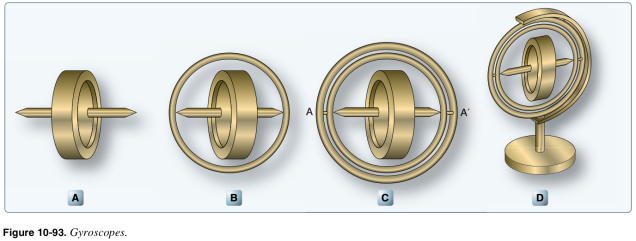
Unless the rotor of a gyro is spinning, it has no unusual properties; it is simply a wheel universally mounted. When the rotor is rotated at a high speed, the gyro exhibits a couple of unique characteristics. The first is called gyroscopic rigidity, or rigidity in space, meaning the rotor of a free gyro always points in the same direction no matter which way the base of the gyro is positioned. [Figure 10-94]
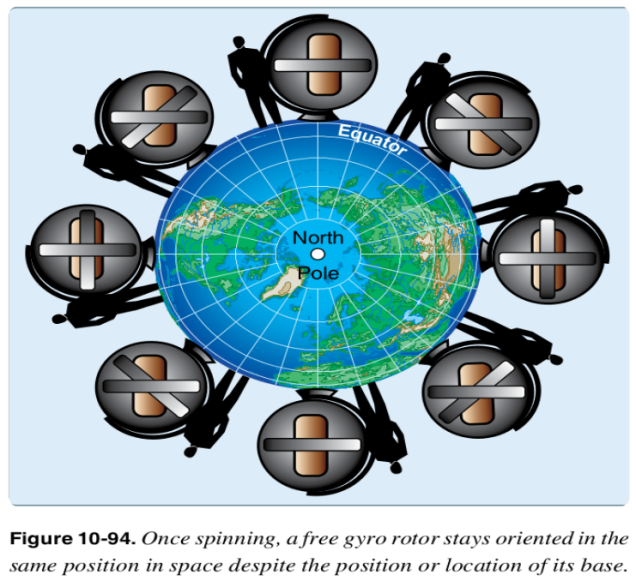
Gyroscopic rigidity depends upon several design factors, including rotor weight, angular velocity, rotor radius and bearing friction
The characteristic of gyros to remain rigid in space is exploited in the attitude-indicating instruments and the directional indicators that use gyros.
Precession is a second important characteristic of gyroscopes, but I won’t go into detail here, suffice to say that by applying a force to the horizontal axis of the gyro, a unique phenomenon occurs.
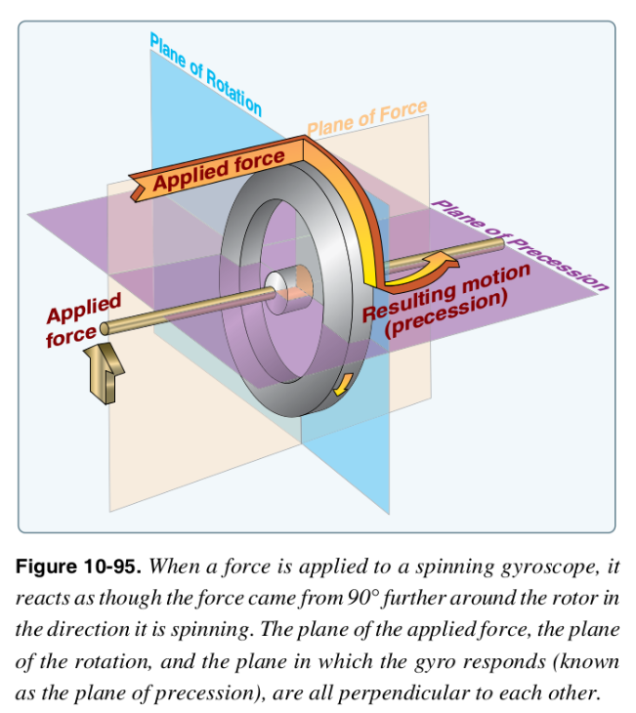
There are also Solid State Gyros and Related Systems like Microelectromechanical Based Attitude and Directional Systems (MEMS) & Ring Laser Gyros (RLG) but those are beyond the scope of this post.
So What Do Pendulous Vanes Actually Do
The attitude indicator, or artificial horizon, is one of the most essential flight instruments. It gives the pilot pitch and roll information that is especially important when flying without outside visual references. The attitude indicator operates with a gyroscope rotating in the horizontal plane. Thus, it mimics the actual horizon through its rigidity in space. As the aircraft pitches and rolls in relation to the actual horizon, the gyro gimbals allow the aircraft and instrument housing to pitch and roll around the gyro rotor that remains parallel to the ground.
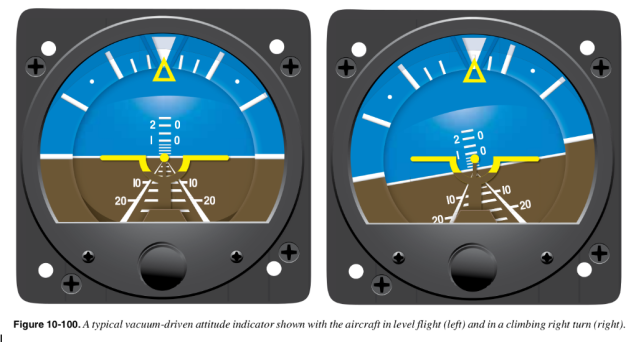
In a typical vacuum-driven attitude gyro system, air is sucked through a filter and then through the attitude indicator in a manner that spins the gyro rotor inside. An erecting mechanism is built into the instrument to assist in keeping the gyro rotor rotating in the intended plane. Precession caused by bearing friction due to air contaminants and other factors makes this necessary.
After air engages the scalloped drive on the rotor, it flows from the instrument to the vacuum pump through four ports. These ports all exhaust the same amount of air when the gyro is rotating in the horizontal plane. When the gyro rotates out of plane, air tends to port out of one side more than another. Vanes close to prevent this, causing more air to flow out of the opposite side. The force from this unequal venting of the air re-erects the gyro rotor. [Figure 10-101]
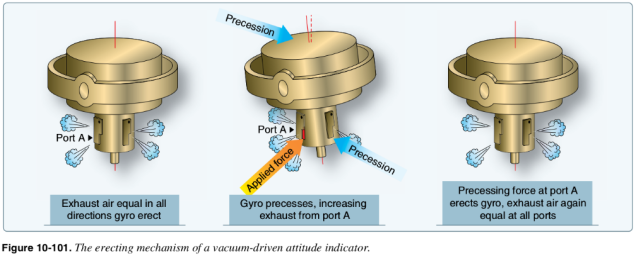
Early non-pendulous vane vacuum-driven attitude indicators were limited in how far the aircraft could pitch or roll before the gyro gimbals contacted the stoppers, causing abrupt precession and tumbling of the gyro.
Many of these gyros include a caging device. It is used to erect the rotor to its normal operating position prior to flight or after tumbling. More modern gyroscopic instruments are built so they do not tumble, regardless of the angular movement of the aircraft about its axes.
Failings Of The Vacuum Gyro System
In addition to the contamination potential introduced by the air-drive system, other shortcomings exist in the performance of vacuum-driven attitude indicators. Some are induced by the erection mechanism itself.
The pendulous vanes that move to direct airflow out of the gyro respond not only to forces caused by a deviation from the intended plane of rotation, but centrifugal force experienced during turns also causes the vanes to allow asymmetric porting leading to inaccurate display of the aircraft’s attitude, especially in skids and steep banked turns. Also, abrupt acceleration and deceleration imposes forces on the gyro rotor. Suspended in its gimbals, it acts similar to an accelerometer, resulting in a false nose-up or nose-down indication.
Electric attitude indicators Vs Pendulous Vanes
Electric attitude indicators address some of the inherent problems of vacuum-driven attitude indicators. Since there is no air flowing through an electric attitude indicator, air filters, regulators, plumbing lines and vacuum pump(s) are not needed.
Contamination from dirt in the air is not an issue, resulting in the potential for longer bearing life and more accuracy. Erection mechanism ports are not employed, so pendulous vanes are eliminated.
It is still possible that the gyro may experience precession and need to be erected. This is done with magnets [not gravity] rather than vent ports. Typically, electric attitude indicator gyros can be caged manually by a lever and cam mechanism to provide rapid erection. [Figure 10-102]
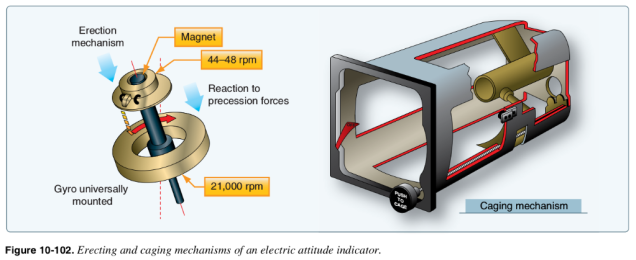
So as we can see, pendulous vanes have their uses and weaknesses, but one task they cannot perform is the mythical correction for the non-existent curvature of the earth. The simple principles of rigidity in space and precession provide all the knowledge capable of determining whether we are living on a spinning, hurtling, orbiting ball. The only conclusion that we can draw is that the earth is a stationary plane.
Here you can listen to a pilot of over 35 years discuss the gyroscope as the best flat earth proof, whilst explaining the myth of the pendulous vane.
RIP SPINNING BALL EARTH
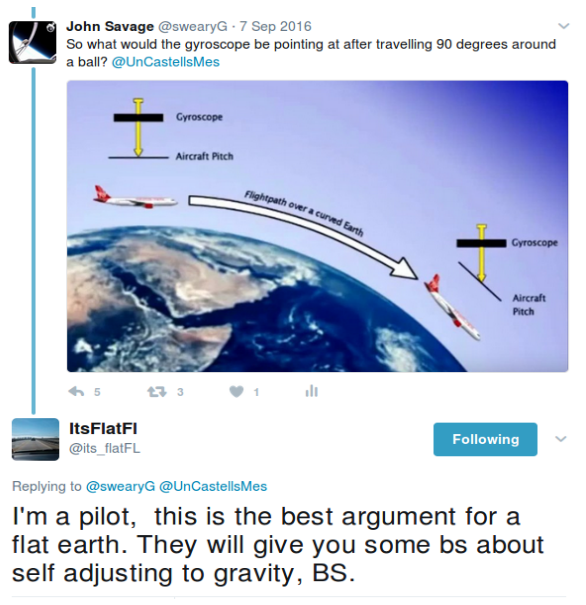
LINKS
Click to access PPL-1.1.3-Aircraft-Instruments.pdf
Click to access AircraftInstruments.pdf
http://www.faatest.com/books/IFRH/4-5.htm
Patent sperry pendulous vanes gyroscope attitude indicator 1946
Patent gyroscope horizon 1892
http://www.pilotfriend.com/training/flight_training/fxd_wing/attitude.htm
Thanks for your continued work on these things, John. Tim
LikeLiked by 1 person
You’re misunderstanding the purpose of the magnet in the erection mechanism. The magnet is only there to make the mechanism turn slowly at 44-48rpm. In your diagram the two little black arcs on the erector are (very poor) representations of metal balls. It looks like the artist was colorizing the FAA’s black and white version of this diagram and didn’t know what he was seeing. The FAA version is clearer, but has a slight flaw in the right hand ball that may have confused the artist. Between the two balls is a small wall built into the erector. The balls are free to roll around the periphery of the erector under the pull of gravity, except that when the the wall comes round it sort of slowly pushes the ball up one side of the erector. When the ball is being pushed up that side of the erector, the gravity pulling down on the ball causes a torque on that side of the gyro to cause the gyro to precess in the direction to bring the gyro upright. When the ball gets to the top it can roll freely and relatively quickly back down to the lower side of the erector, waiting for the wall to come round and push it back up again. Thus by this mechanism, the ball spends more time on one side than the other until the gyro is brought up level to the direction of gravity.
LikeLike
If I am misunderstanding the role of the magnet and steel balls, then so is The Aviation Safety Bureau (http://content.aviation-safety-bureau.com/allmembers/faa-h-8083-31-amt-airframe-vol-2/sections/chapter-10.php)
That state “It is still possible that the gyro may experience precession and need to be erected. This is done with magnets rather than vent ports.”
And is confirmed by the FAAtest Aviation Library (http://www.faatest.com/books/IFRH/4-5.htm)
The only misinformation is to describe the action of the vanes and steel balls as a result of (fictional) gravity, and not the simple principles of density and buoyancy.
The assertion that gyroscopes would not function, as they do, on a spinning ball, still stands as self-evident
Thanks for your comment
LikeLiked by 1 person
“and not the simple principles of density and buoyancy.”
In terms of significance – Air is equal density in all directions around a small stationary object.
Density as a property has no directional causality.
Also, you seem to propose that objects seek out greater density rather than the least resistance observed in all other dynamic systems.
It’s a shame to see you censor posts that aren’t trolling here.
LikeLike
I can’t blame you for being misled by the sentence: “This is done with magnets rather than vent ports.” I’d say that sentence is not really correct. Technically it could be considered true because magnets are involved in an important way. But the magnet’s only purpose is to spin the sleeve slower than the main shaft. The fundamental mechanism of the erection is the downward force of the balls on the sleeve causing precession back into a level position. It’s misleading for that sentence to mention a minor part of the process as if it was the central principle.
We need not dispute models of gravity. For the puposes of discussing erection mechanisms we can use your model of gravity as density and buoyancy. When we mention gravity, we can just assume by the word ‘gravity’ we mean the effects of density that cause dense things to go down. Despite that paragraph starting off with that poor sentence, it goes on to state correctly in an incomplete way how it works:
“If the pull of gravity is not aligned with the axis of the gyro, the balls fall to the low side. The resulting precession re-aligns the axis of rotation vertically.”
So it is saying that the balls roll down to the low side and, because of their density if you like, the downward force they exert on the sleeve makes the gyro precess. Whoever wrote that either probably didn’t understand gyros very well, or they just felt they had to leave out the complicated parts of the explanation, because they didn’t mention the need for the little wall on the sleeve that pushes the balls back up to the top. If it was simply the weight of the balls at the bottom of the sleeve, the balls would cause a precession, but it would just make the gyro precess around in a circle, never getting it back upright. The little wall makes the balls spend more time on the side where they’re going up, instead of just on the bottom. They need to spend more time on the side going up in order to get the correct precession in the right direction to get the gyro erect. But regardless of that detail, would you agree that it is the downward force of the balls on the sleeve (due to density if you prefer) that causes the gyro to precess back up to a level orientation? I’m not asking if you are certain that that is correct, I’m just asking if it looks to you like that is probably true.
LikeLiked by 1 person
That is exactly how I understand the mechanism to work, It is based on the same principle as the pendulous vanes, utilising the properties of density to dampen the effects of the mechanism and try to remain erect. It is poorly written but it essentially explains that steel balls are used instead of pendulous vanes.
The assertion that gyroscopes would not function, as they do, on a spinning ball, still stands as self-evident
Cheers for the comment
LikeLiked by 1 person
I realized a good analogy as to why saying the erector “is done by magnets” is wrong. It’s kind of like saying car engines run on magnets. It’s true that magnets are important parts of car engines, such as in the ignition coils or alternators, but it’s misleading to the point I would say it’s just false to claim that car engines run on magnets.
LikeLike
So if the tendency that dense objects like the steel balls or pendulous vanes have, to go down, is used by the artificial horizons to continually adjust the gyro spin axis down, then wouldn’t that explain why as the plane flies around the ball earth that the gyro axis continues to be perpendicular to the ground? Because as the direction that dense objects fall, changes to point to the middle of the earth, the gyro continually adjusts to that changing direction? I’m not asking you to agree that the earth IS a ball and that the direction that dense objects fall, does change to point to the center of the earth, but just that IF it did, wouldn’t the erection mechanism just adjust to that changing direction?
LikeLiked by 1 person
Since the concept of self erection would work in either the ball model or flat earth, insofar as both aim to keep the spin axis perpendicular to the ground, it’s not a good proof of either model. However the purpose of this post was to dispel the notion that self erection mechanisms are in anyway proof of a ball earth.
Let’s also not forget that many record breaking flights were made using simple mechanical gyroscopes many years before the invention of self erecting mechanisms, like pendulous vanes.
LikeLike
The flights made with earlier non-correcting gyros had errors.
Pilots had other mechanisms of manual correction where they align the gyro with the visible horizon.
Also, you don’t need an artificial horizon to fly in zero visibility. You can rely on other instruments. It’s just more difficult to do so. Part of the instrument pilot exam is flying with a failed vacuum system.
LikeLike
Oh, ok I see. You’re right that the erection mechanism doesn’t provide any significant evidence of a ball earth, because its main purpose is just to correct for gyro errors caused by other things like bearing friction. You might want to revise your article a bit to make what you’re saying clear that the erection mechanisms could correct for the curvature if it was there, but that’s not the mechanism’s main purpose.
I was also wondering about this idea that there is no gravity. There are even some mainstream science sources that say there is no gravity force. Brian Cox’s great feather and bowling ball in the vacuum chamber video, says something like that at the end. If you haven’t seen that video, I highly recommend you look it up. But I expect that even Brian Cox will often talk about the force of gravity if he is trying to do a simple analysis of some situation that doesn’t require relativity. Nobody seems to really know what gravity is. I think we can all agree that there does exist a phenomenon where heavy or dense things tend to fall down. But nobody seems to know ultimately why. Models vary. Relativistic gravity says Newtonian gravity is a little wrong (or a lot wrong in some extreme circumstances). Then there’s the Density and Buoyancy model of why things fall, which may have some other differences.
There seems to be a downward force associated with heavy objects. For example if you hang a weight from a spring scale, the spring stretches as if there was a force pulling on it. It’s like there was a magnet down underground that pulls everything down. It apparently seemed natural for some people to describe gravity as this invisible force. An invisible, magic like force, wasn’t such a big leap because there was the example of magnets doing a very similar seemingly magical invisible force. I have to admit that I find magnets to be very strange. But now I guess, Relativity says there is no force, it’s just moving through space/time or something. Ok that’s fine with me. But whether it is density and buoyancy, a force, spacetime, or whatever, it seems like we need a label for the phenomenon of things falling forcefully. “Gravity” is the label I’ve gotten used to.
Have you thought about creating a label for the phenomenon that makes dense objects fall? The word density is used a lot in this context, but it already has another definition which is “mass per unit volume”. And that’s “mass”, not “weight”, per unit volume, because an unchanging mass can have its weight change as it goes to different environments. Are you familiar with the difference between mass and weight? Of course having another definition doesn’t mean the word density can’t do double duty with two different definitions. Even scientists do that occasionally. It would probably be best though to have a special word for the phenomenon.
When coming up with a name for a phenomenon, it may be useful to find a name that somehow describes the differences between the old model and the new model. I have to say though that I think you’re going to have a hard time finding any differences between the predictions of how things move according to the scientific gravity model and the density buoyancy model. Scientists have extensive descriptions, definitions, observations, experiments, and research on gravity, density, buoyancy, pressure and other things related to how things move. From what I’ve seen, their models seem to do a pretty accurate job of describing the way things move. And these things are more easily tested than going to space. At least many, and probably the vast majority of phenomenon of gravity, density, buoyancy, and pressure can be fairly easily tested in home laboratories with inexpensive equipment, so it would probably be much harder to maintain a fake theory without word getting out. But then if you can’t identify any particular testable differences in how the two models predict things will move, then maybe it makes more sense to just stick with the word gravity to describe the phenomenon.
LikeLiked by 1 person
You are correct that there is a problem with the word ‘Gravity’. On the one hand gravity is a word that adequately describes the properties and actions of density, ie. heavy objects fall ‘downwards’ in less heavy mediums. I have no problem agreeing with the description of ‘gravity’ in this terrestrial setting, as these are observations anyone can test, measure and repeat.
The problems arises when gravity is also used to describe ‘planetary’ motions, actions at a distance, adherence of water to spinning globular object in a vacuum. Gravity is used to describe how the moon can create tides (but only in salt water bodies), and how the earth has captured the moon, and how we all orbit a vast distant sun. In this setting (cosmological gravity as opposed to terrestrial gravity) nothing can be tested, nothing has been proven of this vacuum environment, we can’t observe what is claimed, and what is claimed doesn’t not always fit in with what is observed.
It is because of the blurring of definitions from the testable to the philosophical, that I don’t like to use the term gravity.
Even Newton was appalled at the idea of action at a distance being attributed to him. He said
“Tis unconceivable that inanimate brute matter should (without the mediation of something else which is not material) operate upon & affect other matter without mutual contact; as it must if gravitation in the sense of Epicurus be essential & inherent in it. And this is one reason why I desired you would not ascribe {innate} gravity to me. That gravity should be innate inherent & {essential} to matter so that one body may act upon another at a distance through a vacuum without the mediation of any thing else by & through which their action or force {may} be conveyed from one to another is to me so great an absurdity that I believe no man who has in philosophical matters any competent faculty of thinking can ever fall into it. Gravity must be caused by an agent {acting} constantly according to certain laws, but whether this agent be material or immaterial is a question I have left to the consideration of my readers.”
Before ‘cosmological gravity’ can even be considered, proof needs to be shown that we do indeed live on a spinning ball in space. Until then, ‘properties of density and buoyancy’ will have to suffice for me.
As a proponent of the electric universe, I would ascribe the reason for up and down to an electrostatic change on the face of the plane of earth. A very small differential, but enough to determine up from down. But that’s just my opinion.
Cheers for the comment
LikeLike
Polite people debating with intelligent well presented arguments cracks me the fvck up. I can’t help it. A spade’s a spade fvcktards. Call it so …
The aircraft clearly flies forward along a straight line vector, not a curved vector. There’s no such thing as a curved vector victor …
You fvcktards can wank on all day about whether a pendulous vane is a throbbing damping mechanism or an erectile dysfunction blue tablet the FACT still remains that there is NO ADJUSTMENT, none, nada, zip to the FWD Flight Path Vector when flying at 550mph over the surface of a globe.
… and I’m not sorry to be so “savage” because it’s a fvcking fact. You’d be on an express elevator ride to hell …. going down IF IT DID 🙂
LikeLike
From what I’ve seen, their modellings appear to do a pretty accurate line of work of describing the room things move. I have got to enounce though that I consider you’re going to have got a surd clock time determination any differences between the predictions of how things move according to the scientific somberness modelling and the denseness irrepressibility modelling.
LikeLike
Hello Savageplane
I am also A Flat Earther and thank you for your work!
I am highly convinced that the gyroscope provides the means to kill the globe.
But as I was doing my own research to this Topic I discovered that you must have overlooked something that needs Correction.
I did a deep research of Elmer Sperry’s work and found flowing information:
also Sperry helped with the first complete blind flight using only instruments by the Pilot
James Harold Doolittle on 24 of September 1929
http://ethw.org/Milestones:First_Blind_Takeoff,_Flight_and_Landing,_1929
the first Patent for a Gyro driven Artificial Horizon was filed by him on the 15 of August 1933
Patent NR: US002044151 http://pdfpiw.uspto.gov/.piw?docid=02044151&SectionNum=3&IDKey=658932443095&HomeUrl=http://patft.uspto.gov/netahtml/PTO/patimg.htm
The Patent was Given on the 16 of June 1936.
In the Drawings the Pendulous Vane are shown and labeled with the nr 13
and under Specifications in line 50 it talks about there function.
Clearly Elmer Sperry had the Pendulous Vane already build in his first Patent for the first Gyro driven Artificial Horizon. So far I could not find any evidence that Gyro driven Artificial Horizons where in use in Airplanes before 1929.
LikeLike
Hello Again
I did found some Sources stating that First Gyro driven Artificial Horizon in Air plains where in use as early as 1916 but could not surly verify this.
http://www.gyroscopes.org/history.asp
The Patent NR. 505575 http://pdfpiw.uspto.gov/.piw?Docid=00505575&idkey=NONE&homeurl=http%3A%252F%252Fpatft.uspto.gov%252Fnetahtml%252FPTO%252Fpatimg.htm you refer to, mentions in the front page that the Inventor was manly thinking about ships, also he did not rule out other use for it. Anyhow I could not make out any Pendulous Vane mechanism in his drawings. If this Gyroscopic Artificial Horizon can be proofen to have been used in Airplanes before Elmar Sperry’s it would Indeed be Proof that It would have worked without the Correction Mechanism in place.
Also in the report Of James Harold Doolittle”s first flight relaying only on Instrument,
Sperry and his Gyroscope Company are mentioned I could not verify to my satisfaction,
witch Artificial Horizon was used and if it matched the Model Sperry was Patenting 6 Years later. Witch would mean it would have the Pendulous Vane Mechanism in it.
http://ethw.org/Milestones:First_Blind_Takeoff,_Flight_and_Landing,_1929
I can verify that indeed a Artificial Horizon was used in Doolittle”s Flight as seen in the Artie above… Fig3 on the left side of the Cockpit. he Flew a NY-2 Husky Model with Hood.
Concerning the Flight of Alcock and Brown in a Vickers F.B.27 Vimy https://de.wikipedia.org/wiki/Vickers_Vimy i was unable to verify if any Artificial horizon was in use and witch model ore if it was indeed a Gyroscopic one.
I found One Picture supposedly of the Cockpit of a Vickers Viking here:
https://ixquick-proxy.com/do/spg/show_picture.pl?l=deutsch&rais=1&oiu=http%3A%2F%2Faviadejavu.ru%2FImages6%2FFT%2FFT1921%2F10%2F657-2.jpg&sp=299fa696a86bcc9c6ce858834cdfee07
Not sure what I am seeing here and if it matches the cockpit of a Vimy
After I could clearly show that Sperrys Artificial Horizon did have a Pendulous Mechanism your assumption that such mechanism could not have existed before 1941 is unfortunately wrong.
I did indeed existed In the first recorded Patent of Sperry as early as 1933, furthermore I was unable to establish if any other instrument was used before that time that did not have such mechanism.
As we can not defend the truth with false claims (also when accidental) I hope you will change the article accordingly so we give no grounds to those that are to happy to Step on any mistake we make. In the next Post I will make a suggestion how we can truly clarify once and for all that Pendulous Vane do not Compensate for the curvature of Earth.
If my English grama is not 100% correct pleas excuse me its not my mother language 😉
LikeLike
Here it is:
In order to clarify once and for all, if Pendulous Vane compensate for Curvature of the Globe.
I would suggest following Test:
A Artificial Horizon should be created witch is in a Transparent Housing so all Parts can be observed while in action. This Artificial Horizon shalt have no Pendulous Vane Mechanism ore any thing like it ore have them surly made useless.
This Artificial Horizon should be taken alongside the normal instruments
(as means for reference)
in a Plain and the Aircraft shall be brought to cruising altitude.
For the Period before and at the Test no sudden ore rough Movements of the Air plain shall occur!
Some soft maneuvers before and after the test might be Performed in oder to show that the test Horizon dose indeed do his job properly to show attitude indication correctly.
Then the Plain should fly for at least one Hour with steady speed, altitude and direction.
The whole test should be Recorded on film with uncut material over the whole length of the test.
If the Earth is indeed a Globe,
the Test Horizon must roll down!
If the Earth is Indeed flat,
the test horizon must remain Level during the one Hour straight flight.
LikeLike
I agree with Mr. James Thomas. I do not believe the Earth is a spinning ball hurling through space, but I do agree that IF there was a curvature, the erection mechanisms on modern gyro attitude indicators would compensate for it and keep the gyro rotor axis aligned with the gravity vector. Unfortunately, and due to this, I do not believe, as I once did, that the gyroscopic attitude indicator is the smoking gun debunking the spherical earth model.
Fascinating discussion though.
LikeLike
The very root of your writing whilst appearing reasonable initially, did not settle very well with me after some time. Someplace within the sentences you actually managed to make me a believer but just for a very short while. I nevertheless have a problem with your jumps in assumptions and one would do well to fill in all those breaks. In the event that you actually can accomplish that, I will certainly end up being fascinated.
LikeLike